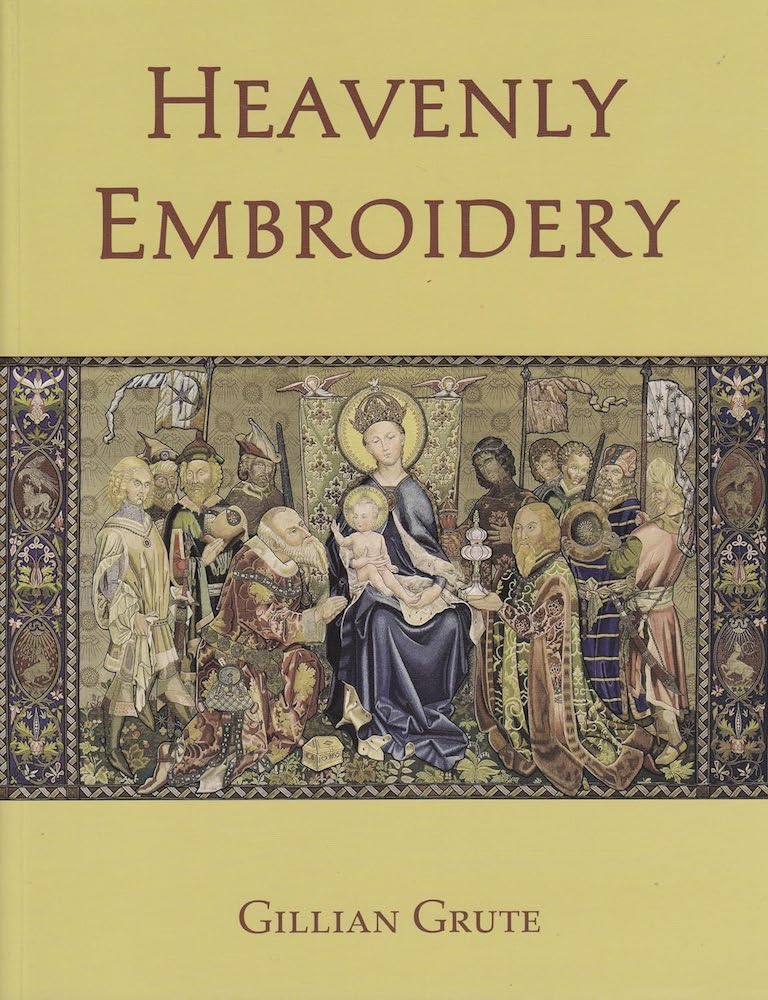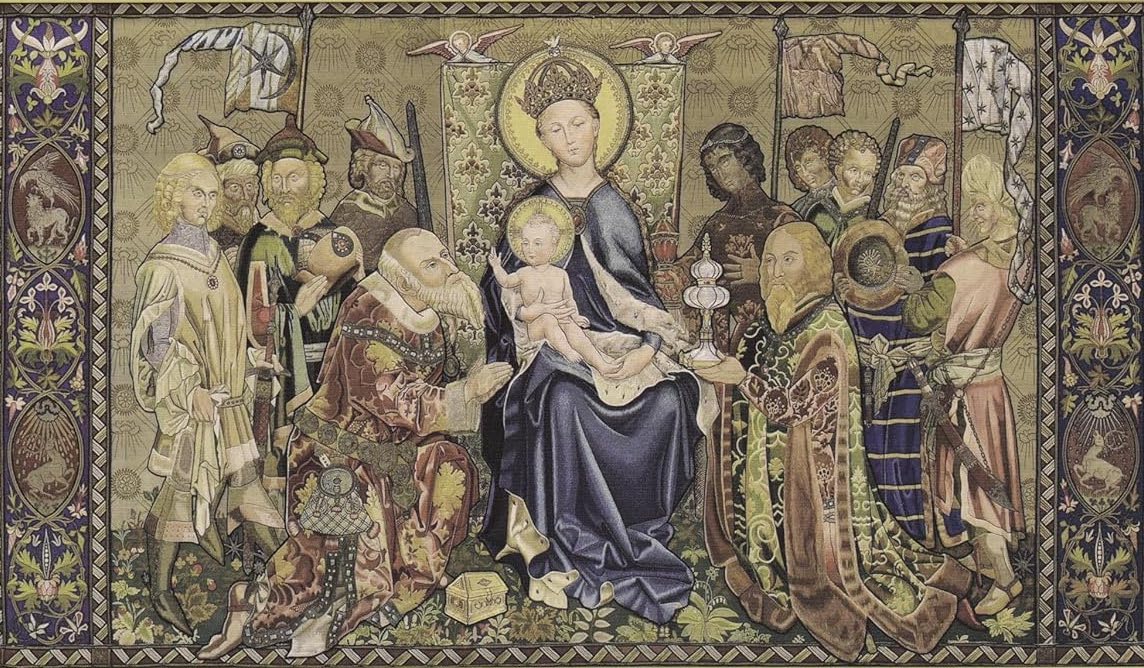
In The Present State of Ecclesiastical Architecture in England (1843) Augustus Pugin , discussing needlework in churches, wrote "It is most gratifying to perceive that true ideas on these matters are fast spreading themselves, and it is fervently to be hoped that they will eventually cause a better style of work to be introduced amongst those ladies who profess to embroider for the church." In time his hope was granted and he would have been amazed, and surely gratified, even if styles changed somewhat, to see the later wondrous and highly skilled work of the Sisters of the Poor Child Jesus, the subject of Gillian Grute’s Heavenly Embroidery.
This order originated in Germany, and The Community of the Child Jesus, as it was first named, was founded by Mother Clara Fey (1815-1894) with close associates, in Aachen, in 1844, with the intention of teaching, housing, and caring for orphan and impoverished young children, mainly girls. Mother Fey, already a competent needlewoman, was joined in 1846 by Anna Maria Kauff (Sister Franzisca), who was particularly skilled in embroidery and design, and who took responsibility for the embroidery workrooms throughout the order, which had spread rapidly and which by 1862 had established nineteen houses. Although this book is particularly concerned with embroidery undertaken in England at Southam, Warwickshire, the skills and artistry of the Sisters had already become well known in Germany, as evidenced, for example, by the very fine and immensely detailed 1862 Adoration of the Magi they produced, the composition of which was derived from an altarpiece by Stefan Lochner (c.1410-1501) in Cologne cathedral. However, the emergence of Bismarck, who became imperial chancellor in Germany after the Franco-Prussian war of 1870-71, changed everything. Bismarck repressed Catholicism and its influence in favour of secular state government. The Congregation’s houses and schools were closed and the Sisters had to leave their native country.

A closer view of the Adoration of the Magi of 1862, as featured on the fron cover of the book.
In England, they managed to establish a house in Southam in 1876, greatly assisted by Mary Edgar, a Scottish convert who had settled in Aachen by 1848, and the supportive Father Grosvenor, chaplain at St Mary’s Priory, Princethorpe, also in Warwickshire. Both Mary Edgar and Father Grosvenor had similar philanthropic aims to the Sisters, and were anxious to see them suitably established in England. It was Mary Edgar who had originally shown the Sisters in Aachen art prints of designs by Pugin to help inspire their embroidery.
The embroidery workrooms, eventually set up by the sisters in Southam, were organised professionally and methodically; skills were graded, with only the elite few being allowed to execute figure work, and, in particular, faces. Pattern books were created from photographic prints made of the work, and could be shown to clients. The designs which the sisters created themselves and collected were copied and distributed to other workshops within the Congregation. Techniques were complex; selected designs and motifs were traced onto the intended fabric and fixed, before stitching could start. Embroidery silks were extremely closely graded (‘hair silks’ being the finest) in tint and thickness, and the variety of stitches was sophisticated. The embroiderers worked very hard, sometimes up to ten hours a day. The zeal and commitment paid off, and although it was hard to get commissions in England to start with, the Sisters were producing work to order from 1878 onwards, all to support themselves and their work of caring for and teaching orphans.
Although the Sisters collected many images and designs for their work, which was necessarily full of religious symbolism - appropriate saints, for example, and their emblems, when it came to big compositions they sometimes worked with outside architects and designers, such as Thomas Garner, F.A. Walters, J. A. Pippet, and Dunstan Powell, the last two closely associated with the Hardman firm. These influences gave a slightly different character to the depictions on the different sets of vestments; for example the very pictorial martyrdom of St Thomas of Canterbury, on a hood on one of the Conrad vestments, referred to below, has a different flavour to that of the more medievalising scenes, with which Thomas Garner was involved, for Erdington Abbey.
Outstanding in the Sisters’ oeuvre in the late 1880s were a set of low mass vestments for use in Downside Abbey, ordered by Robert Berkeley, member of a long established local aristocratic Catholic family in 1895, and a high mass set of vestments for Downside Abbey, commissioned by Dom Conrad Bankaert. In 1898 the workroom at Southam executed a remarkable set of vestments and other items for Erdington Abbey near Birmingham, for J.B.M. Camm, at a period described by Grute as "the Golden Age of the workroom." These were particularly sumptuous, and rich in colour, and together with the earlier commissions helped to promote the Sisters’ wonderful embroidery and assist in funding their work with children.
The commissions described above were but the tip of the iceberg; the output of the Sisters of the Poor Child Jesus was extensive and it is remarkable to consider that even in a more secular age they were still working as late as 1968, their last known commission being two mitres for Auxiliary Bishop A. Emery, Birmingham.
In addition to its text, and many excellent, often full page, illustrations, Heavenly Embroidery also contains four informative Appendices and a useful Glossary, subdivided into "Needlework" and "Vestments" - very helpful to the general reader.
As Pugin himself said, "The generality of persons are but little acquainted with the extreme beauty of the embroidery worked for ecclesiastical purposes during the Middle Ages." This fascinating book, written and researched with care and commitment by Gillian Grute, shows how communities such as the Sisters of the Poor Child Jesus, by their resourcefulness and skill, resurrected this beauty so successfully at a much later period.
Bibliography
Grute, Gillian. Heavenly Embroidery. Leominster, Herefordshire: Gracewing, 2023. 160 pp. £14.99. ISBN 978-0-85244-712-3
Created 9 March 2024